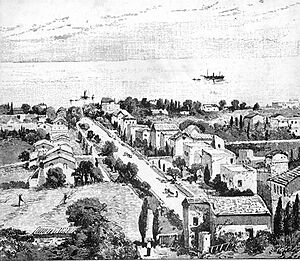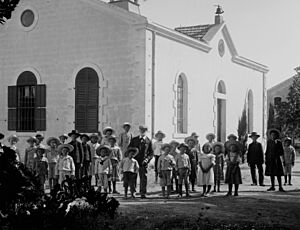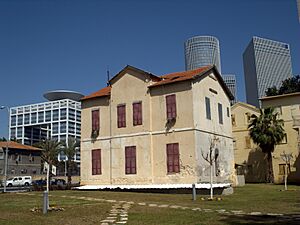Templers (Radical Pietist sect) facts for kids
The German Templer Society, often called Templers, was a special religious group from Germany in the mid-1800s. Its founders, Christoph Hoffmann and Georg David Hardegg, believed that people could find salvation by living together in a Christian community. They also thought that Jesus would return soon, and that this would happen in Jerusalem. They felt God's people should gather there to help rebuild the temple, as mentioned in the Bible. In October 1868, Hoffmann and Hardegg, along with their families and friends, arrived in Haifa, Palestine, to start their first community.
Contents
What Does 'Templer' Mean?
The name Templer comes from the idea of a Christian community as described in the New Testament. In the Bible, it says that each person and the community itself are like temples where God's spirit lives (see 1 Corinthians 3:16 and 1 Peter 2:5). It's important to know that the Templers have no connection to the old Medieval Knights Templar.
How the Templer Society Started
Christoph Hoffmann met Georg David Hardegg in 1849. They became good friends. By 1853, Hardegg shared Hoffmann’s dream of creating a Christian community.
At first, the Templer group was called the "Friends of Jerusalem." In 1855, Hoffmann announced their goal in their newspaper, the Sentinel. He said they wanted to live according to God's word. He also believed that the world would only be fully converted after Jesus's second coming.
In 1856, Hoffmann and Hardegg moved with their families and other "Friends of Jerusalem" to a place called Kirschenhardthof in Germany. They built a successful community there. They also started planning their move to Palestine and changed their name to the Temple Society.
The main church in Germany, the Lutheran state church, did not like the Templers. They saw them as leaving the church. However, some Prussian Protestants were a bit more understanding. Hoffmann's older brother, Wilhelm, who was still part of the official church, helped Christoph meet with Frederick William IV of Prussia. The King at first seemed interested in helping the Templers. But later, he said he could not support them. Despite this, Hoffmann kept hoping the King would change his mind.
Even with objections from churches and some members leaving, Hoffmann and Hardegg went on a trip to Palestine. They left on February 9, 1858, with a farmer named J. Bubeck. They arrived in Jaffa on March 14, 1858. They visited many places like Jerusalem, Bethlehem, and Haifa before returning home.
On August 6, 1868, Hoffmann, Hardegg, their families, and other Templers finally left Germany for Palestine. They landed in Haifa on October 30. They had decided that Haifa was the best place to settle because it had a good harbor and climate. They had also planned which jobs and skills were needed for their new community.
Building Communities in Palestine

In 1868, Hoffmann and Hardegg bought land at the foot of Mount Carmel and started a colony there. At that time, Haifa had about 4,000 people. The Templers helped the city grow a lot. They built a beautiful main street, 30 meters wide, with trees on both sides. Their houses were made of stone with red roofs, which was different from the flat roofs common in the area. It was hard work, and many people died from the tough climate and diseases before the colony became strong. Hardegg stayed in Haifa, but Hoffmann went on to start other communities.
Around the same time, Bahá'u'lláh, the founder of the Baha’i Faith, arrived in the Haifa-Akka area as a prisoner. Later, he visited the Templer Colony on Mount Carmel many times. He even wrote a letter to Hardegg. He asked his son to build a shrine for the founder of his religion on Mount Carmel, right in line with the Templer road. Today, the Templer buildings and this shrine are a very important landmark in Haifa.
Hoffmann started another colony in Jaffa a year later. In 1871, he founded a third colony called Sarona. This was the Templers' first farming community. In 1873, a fourth colony was set up in the Valley of Refaim near Jerusalem.
The oranges from the Templer colonies were the first to be sold under the "Jaffa orange" brand. This became a famous brand in Europe and is still used today for Israeli oranges. The Templers also started a regular coach service between cities, which helped tourism. They also made important improvements to roads.
Templer Settlements and Later Years
After the German Emperor Wilhelm II of Germany visited in 1898, a society was formed in Germany to help the Templer settlements in Palestine. This society offered low-interest loans, which helped the settlers buy land for new communities.
More Templer settlers arrived and founded new villages. These included Wilhelma (1902), Bethlehem of Galilee (1906), and Waldheim (1907). At its peak, about 2,000 Templers lived in Palestine.
During World War I, in 1918, the British sent about 850 Templers to a camp in Egypt. In 1920, 350 of them were sent back to Germany. The British took control of the Templers' property. However, after the British government officially took over Palestine in 1920, the Templers started getting their property back. In 1922, the League of Nations officially gave Britain control of Palestine. By 1925, the Templers had full legal rights to their property again.
The British government also paid them half of what they lost during the war. The Templer Society's bank, started in 1925, became one of the main banks in Palestine.
Templers and the Nazi Era
After the Nazis took power in Germany, they tried to control German groups outside Germany. They wanted all Germans to support Nazi ideas. In 1933, some Templers and other Germans in Palestine asked the German government not to use Nazi symbols or boycott Jewish shops. However, they were not successful. Some Templers even joined the German Army. By 1938, 17% of Templers in Palestine were members of the Nazi party. Historians say that younger Templers were more open to Nazi ideas, while older ones tried to fight against them.
When World War II began in 1939, the British authorities in Palestine saw the Templers as "enemy nationals." They were arrested and sent to camps. Many were deported to Australia in 1941. About 661 Templers and other Germans were sent to Australia, leaving 345 in Palestine. During the war, the British government arranged for about 1,000 Templers to be exchanged for 550 Jews who were under German control.
After the war, Jewish people settled in the former Templer colonies. In 1962, the State of Israel paid 54 million German Marks as compensation to the Templers for their nationalized property. Sarona, one of the Templer colonies, became part of Tel Aviv. Some of its original German houses are now part of the Israeli Ministry of Defense. In the early 2000s, Sarona was renovated and became a popular shopping and entertainment area.
Timeline of the Temple Society
- 1861: The Temple Society was founded in Germany by Christoph Hoffmann and others. They planned to move to Palestine.
- 1868: Templers began their planned move to the Holy Land. They started building their first house in Haifa. Over many years, they built towns, farms, schools, and businesses in places like Haifa, Jaffa, and Jerusalem.
- 1874: The Temple Society split, and some members formed a new group.
- 1921: Templers who were held in Egypt during World War I returned to their settlements in Palestine. Their communities grew strong again.
- 1939: German Templers in Palestine were held in camps when World War II started.
- 1941: Over 500 Templers from Palestine were sent to Australia. Some Templers were exchanged for Germans in Palestine.
- 1948: The State of Israel was formed. Templers could not return there, and those still in Palestine had to leave. Today, most Templers live in Australia and Germany.
Temple Society Australia
- 1948-1950: Australian Templers gathered in cities like Melbourne, Sydney, and Adelaide. They built community centers and churches.
- 1950: The Temple Society Australia was officially formed.
- 1972: The Templer Home for the Aged opened in Bayswater, Australia.
- 1986: Templers in Germany and Australia celebrated 125 years of the Temple Society.
- 2002: A new Temple Chapel was built in the Bayswater Community Centre.
Temple Society in Germany
- 1949: The Templer newspaper, Die Warte des Tempels, started publishing again after a 10-year break.
- 1950: A management office was set up in Stuttgart, Germany, which became a center for meetings and social events.
- 1962: The Tempelgesellschaft in Deutschland e.V. (TGD) was officially formed with a new constitution.
- 1967: A new community center opened in Degerloch, Germany.
Templer Settlements in Palestine (by year)
- 1869-1870: German Colony, Haifa (a mix of different religious groups)
- 1869-1870: German Colony, Jaffa
- 1872: Sarona (a mix of different religious groups)
- 1878: German Colony, Jerusalem (first settlers in 1873, became a colony in 1878, also a mix of groups)
- 1886: Walhalla in Jaffa
- 1902: Wilhelma (only Templer settlers)
- 1906: Bethlehem of Galilee (only Templer settlers)
- 1907: Waldheim (only Protestant settlers)
See also
- Sarona—a former Templer colony, now a neighborhood in Tel Aviv city.




